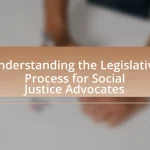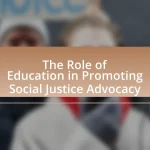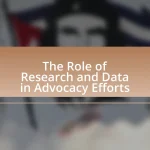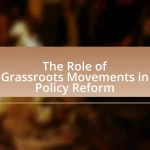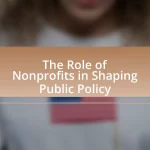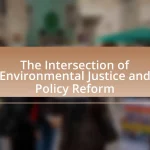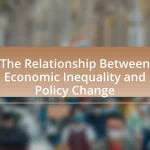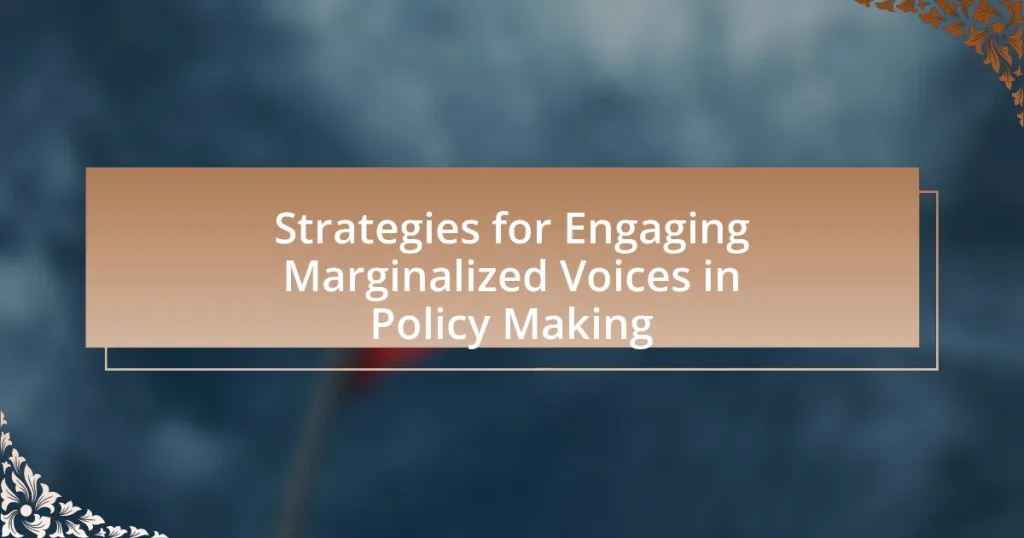The article focuses on strategies for engaging marginalized voices in policy making, emphasizing the importance of inclusive platforms, partnerships with community organizations, and participatory methods. It outlines how these strategies can enhance representation and lead to more equitable policies that reflect the needs of diverse communities. Key topics include the role of community organizations in advocacy, the impact of inclusive practices on policy effectiveness, and the challenges faced by marginalized groups in participating in decision-making processes. Additionally, the article discusses methods for evaluating engagement strategies and the significance of education and storytelling in empowering these voices.
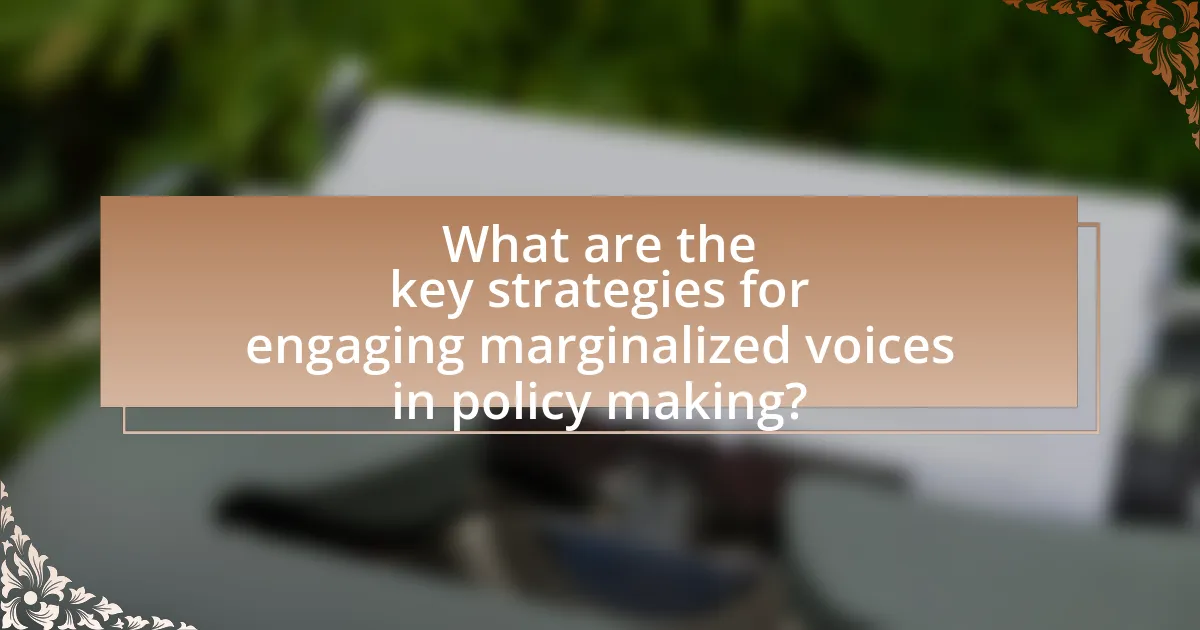
What are the key strategies for engaging marginalized voices in policy making?
Key strategies for engaging marginalized voices in policy making include creating inclusive platforms, fostering partnerships with community organizations, and utilizing participatory methods. Inclusive platforms ensure that diverse perspectives are represented, while partnerships with local organizations help build trust and facilitate outreach to marginalized groups. Participatory methods, such as focus groups and community forums, actively involve these voices in the decision-making process, leading to more equitable policies. Research shows that when marginalized communities are engaged, policy outcomes are more reflective of their needs, enhancing social equity and community resilience.
How can inclusive practices be implemented in policy development?
Inclusive practices can be implemented in policy development by actively involving marginalized communities in the decision-making process. This can be achieved through methods such as public consultations, focus groups, and participatory budgeting, which ensure that diverse perspectives are represented. Research indicates that policies developed with input from affected communities are more effective and equitable; for instance, a study by the National Civic League found that inclusive engagement leads to higher satisfaction with public services and improved community trust in government. By prioritizing the voices of marginalized groups, policymakers can create more relevant and impactful policies.
What role do community organizations play in amplifying marginalized voices?
Community organizations play a crucial role in amplifying marginalized voices by providing platforms for advocacy, education, and representation. These organizations facilitate community engagement, enabling individuals from marginalized groups to express their needs and concerns effectively. For instance, studies show that community organizations often conduct outreach programs that educate members about their rights and available resources, which empowers them to participate in policy discussions. Additionally, organizations like the National Urban League and the NAACP have historically mobilized marginalized communities to influence legislation, demonstrating their effectiveness in shaping public policy.
How can policymakers ensure representation from diverse groups?
Policymakers can ensure representation from diverse groups by implementing inclusive decision-making processes that actively seek input from underrepresented communities. This can be achieved through targeted outreach initiatives, such as community forums and surveys, designed to engage marginalized voices directly in policy discussions. Research indicates that when policymakers incorporate feedback from diverse populations, they create more equitable and effective policies, as evidenced by studies showing improved outcomes in areas like education and healthcare when community input is prioritized.
Why is it important to engage marginalized voices in policy making?
Engaging marginalized voices in policy making is crucial because it ensures that diverse perspectives are represented, leading to more equitable and effective policies. When marginalized communities participate, their unique challenges and needs are acknowledged, which can result in solutions that address systemic inequalities. Research shows that inclusive policy making can improve social cohesion and trust in government, as evidenced by the 2018 report from the United Nations Development Programme, which highlights that inclusive governance leads to better development outcomes and reduces poverty.
What impact does inclusion have on policy effectiveness?
Inclusion significantly enhances policy effectiveness by ensuring that diverse perspectives are considered in the decision-making process. When marginalized voices are included, policies are more likely to address the actual needs and challenges faced by various communities, leading to more relevant and impactful outcomes. Research indicates that inclusive policy-making can improve public trust and compliance, as seen in studies where community engagement led to higher satisfaction rates with local governance. For instance, a report by the World Bank highlights that inclusive policies in urban planning resulted in better resource allocation and community support, demonstrating the tangible benefits of incorporating diverse viewpoints.
How does engaging marginalized communities foster social equity?
Engaging marginalized communities fosters social equity by ensuring that their voices and needs are represented in decision-making processes. This inclusion allows for the identification and addressing of systemic inequalities that disproportionately affect these communities. For instance, research from the National Equity Atlas indicates that when marginalized groups participate in policy discussions, the resulting policies are more likely to reflect their specific challenges and priorities, leading to more equitable outcomes. Additionally, studies show that inclusive engagement can enhance trust in institutions and promote civic participation, further contributing to social equity.
What challenges exist in engaging marginalized voices in policy making?
Engaging marginalized voices in policy making faces several challenges, including systemic barriers, lack of representation, and limited access to resources. Systemic barriers often stem from institutional biases that prioritize dominant groups, making it difficult for marginalized communities to influence decision-making processes. For instance, a report by the National League of Cities highlights that marginalized groups frequently encounter obstacles such as language barriers and inadequate outreach efforts, which hinder their participation. Additionally, the underrepresentation of these communities in policy discussions leads to a lack of understanding of their unique needs and perspectives, further complicating their engagement. Limited access to resources, including funding and information, restricts the ability of marginalized voices to organize and advocate effectively, as noted in research by the Urban Institute, which emphasizes the importance of equitable resource distribution for meaningful participation.
What barriers do marginalized communities face in participating in policy discussions?
Marginalized communities face several barriers in participating in policy discussions, including systemic inequities, lack of access to information, and limited representation. Systemic inequities, such as socioeconomic disparities, often hinder these communities from engaging effectively in policy-making processes. For instance, a report by the National Urban League highlights that low-income individuals frequently lack the resources to attend meetings or access necessary advocacy tools. Additionally, the absence of culturally relevant information can prevent marginalized groups from understanding policy implications, as noted in research by the Center for American Progress, which emphasizes the importance of accessible communication in fostering engagement. Lastly, limited representation in decision-making bodies further exacerbates these barriers, as evidenced by studies showing that diverse perspectives are often underrepresented in legislative processes, leading to policies that do not reflect the needs of marginalized populations.
How can these challenges be addressed effectively?
To address the challenges of engaging marginalized voices in policy making effectively, implementing inclusive frameworks that prioritize representation is essential. These frameworks should incorporate mechanisms for direct participation, such as community consultations and participatory budgeting, which have been shown to enhance engagement and ensure that diverse perspectives are considered. For instance, research by the World Bank indicates that participatory approaches can lead to more equitable policy outcomes, as they empower marginalized groups to influence decisions that affect their lives. Additionally, training policymakers on cultural competency and bias reduction can further facilitate meaningful engagement, as evidenced by programs that have successfully increased the involvement of underrepresented communities in local governance.
How can technology facilitate the engagement of marginalized voices?
Technology can facilitate the engagement of marginalized voices by providing platforms for communication, representation, and advocacy. Digital tools such as social media, online forums, and mobile applications enable marginalized communities to share their experiences, organize collective actions, and influence policy discussions. For instance, the use of social media campaigns has been instrumental in movements like #BlackLivesMatter, which amplified the voices of marginalized groups and brought attention to systemic injustices. Additionally, technology can enhance accessibility through features like translation services and assistive technologies, ensuring that diverse voices are heard in policy-making processes.
What methods can be used to evaluate the effectiveness of engagement strategies?
To evaluate the effectiveness of engagement strategies, methods such as surveys, focus groups, and data analysis can be employed. Surveys can quantitatively measure participant satisfaction and perceived impact, while focus groups provide qualitative insights into the experiences of marginalized voices. Data analysis, including metrics on participation rates and demographic representation, helps assess whether engagement strategies are reaching intended audiences. For instance, a study by the National Coalition for Dialogue & Deliberation found that using mixed methods, including both qualitative and quantitative approaches, enhances the understanding of engagement effectiveness in policy-making contexts.
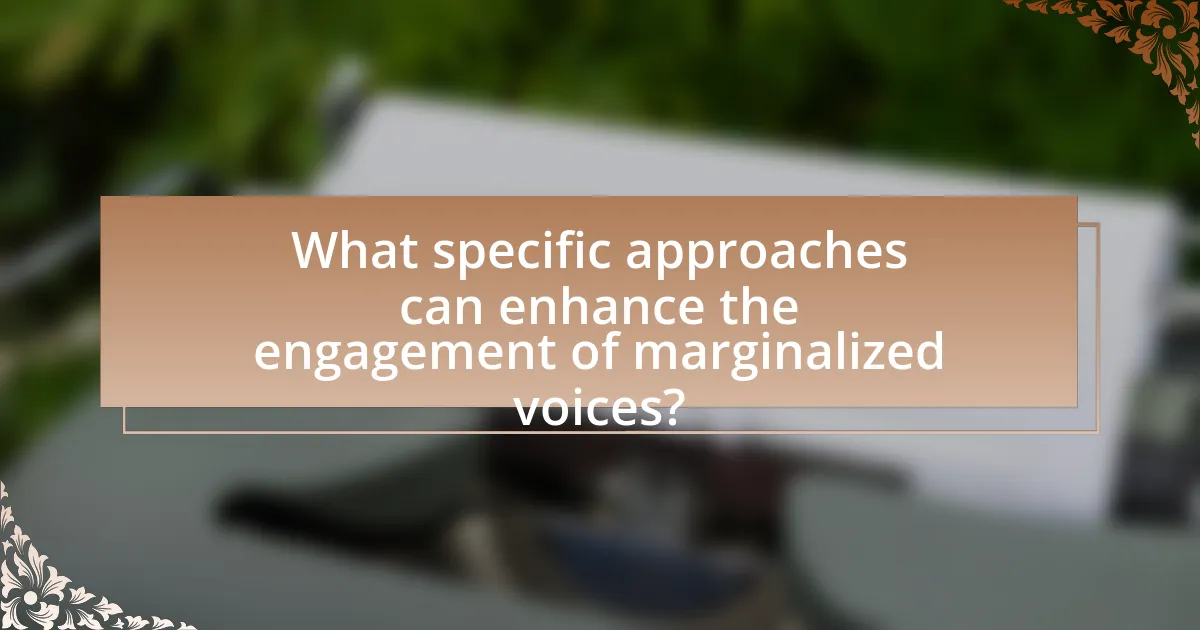
What specific approaches can enhance the engagement of marginalized voices?
To enhance the engagement of marginalized voices, implementing participatory methods such as community-led forums and inclusive policy-making processes is essential. These approaches empower marginalized groups by providing them with platforms to express their needs and perspectives directly. For instance, research by the National Civic League indicates that community engagement initiatives that prioritize the input of underrepresented populations lead to more equitable policy outcomes. Additionally, utilizing technology, such as online surveys and social media outreach, can broaden participation and ensure diverse voices are heard, as evidenced by the success of digital engagement strategies during public consultations in various cities.
How can participatory budgeting empower marginalized communities?
Participatory budgeting empowers marginalized communities by enabling them to have a direct say in the allocation of public funds, thereby increasing their influence in decision-making processes. This approach fosters transparency and accountability, allowing community members to prioritize their needs and advocate for resources that address systemic inequalities. For instance, studies have shown that cities implementing participatory budgeting, such as Porto Alegre in Brazil, have seen increased civic engagement and improved public services in marginalized neighborhoods, demonstrating the effectiveness of this strategy in amplifying the voices of underrepresented populations.
What are the steps involved in implementing participatory budgeting?
The steps involved in implementing participatory budgeting include defining the budget scope, engaging stakeholders, facilitating community meetings, collecting project proposals, prioritizing projects, and allocating funds.
First, the budget scope must be clearly defined to determine which funds are available for participatory budgeting. Next, engaging stakeholders, including community members and local organizations, is essential to ensure diverse participation. Facilitating community meetings allows for open dialogue and the sharing of ideas.
After gathering input, collecting project proposals from community members is crucial for identifying local needs. The prioritization of these projects follows, where community members vote on which proposals should receive funding. Finally, the allocated funds are distributed according to the community’s decisions, ensuring transparency and accountability throughout the process.
These steps are supported by various case studies, such as the successful implementation of participatory budgeting in Porto Alegre, Brazil, which demonstrated increased civic engagement and improved public services.
How does participatory budgeting impact community trust in government?
Participatory budgeting enhances community trust in government by fostering transparency and inclusivity in decision-making processes. When citizens actively engage in budget allocation, they feel a sense of ownership and accountability, which strengthens their relationship with governmental institutions. Research conducted by the Participatory Budgeting Project indicates that cities implementing participatory budgeting have seen increased public satisfaction and trust levels, as citizens perceive their input as valued and impactful. This participatory approach not only empowers marginalized voices but also demonstrates to the community that the government is responsive to their needs, thereby reinforcing trust.
What role does education play in empowering marginalized voices?
Education plays a crucial role in empowering marginalized voices by providing individuals with the knowledge and skills necessary to advocate for their rights and participate in decision-making processes. Through education, marginalized groups gain access to information about their rights, social justice, and civic engagement, which enhances their ability to influence policies that affect their lives. For instance, studies show that educational programs focused on civic literacy increase participation rates among underrepresented communities in local governance and policy discussions. This empowerment through education not only fosters individual agency but also strengthens collective action, enabling marginalized voices to challenge systemic inequalities effectively.
How can educational programs be designed to raise awareness about policy issues?
Educational programs can be designed to raise awareness about policy issues by incorporating interactive learning methods, such as workshops, simulations, and discussions that engage participants directly with the subject matter. These methods facilitate critical thinking and allow individuals to explore the implications of policy decisions in real-world contexts. For instance, research by the National Education Association indicates that experiential learning significantly enhances understanding and retention of complex topics, including policy issues. By integrating case studies and role-playing scenarios, educational programs can effectively illustrate the impact of policies on marginalized communities, thereby fostering a deeper awareness and encouraging active participation in policy-making processes.
What partnerships can be formed to enhance educational outreach?
Partnerships with local community organizations, educational institutions, and government agencies can significantly enhance educational outreach. Collaborating with community organizations allows for tailored programs that address specific needs of marginalized groups, ensuring their voices are included in educational initiatives. Educational institutions can provide resources, expertise, and a platform for outreach activities, while government agencies can facilitate funding and policy support. For example, partnerships between schools and local nonprofits have been shown to improve access to educational resources for underrepresented populations, as evidenced by initiatives like the “Community Schools” model, which integrates academic, health, and social services to support students and families.
How can storytelling be used as a tool for engagement?
Storytelling can be used as a tool for engagement by creating emotional connections that resonate with audiences, particularly marginalized voices in policy making. This method allows individuals to share their experiences and perspectives in a relatable manner, fostering empathy and understanding among policymakers and stakeholders. Research indicates that narratives can significantly influence attitudes and behaviors; for instance, a study published in the journal “Health Communication” found that personal stories can enhance the effectiveness of health campaigns by making the information more memorable and impactful. By incorporating storytelling into policy discussions, marginalized communities can effectively communicate their needs and challenges, leading to more inclusive and responsive policy outcomes.
What are effective methods for collecting and sharing stories from marginalized communities?
Effective methods for collecting and sharing stories from marginalized communities include participatory storytelling, digital platforms, and community workshops. Participatory storytelling engages community members in the narrative process, allowing them to share their experiences in their own words, which fosters authenticity and ownership. Digital platforms, such as social media and dedicated websites, enable broader dissemination of these stories, reaching wider audiences and facilitating dialogue. Community workshops provide a safe space for individuals to express their narratives collectively, often leading to shared themes that can inform policy discussions. Research indicates that these methods not only empower marginalized voices but also enhance the relevance of policy-making by incorporating diverse perspectives. For instance, a study by the Ford Foundation highlights that participatory approaches significantly improve community engagement and representation in policy processes.
How can storytelling influence policy decisions?
Storytelling can influence policy decisions by humanizing complex issues and making them relatable to policymakers. When narratives are shared, they provide context and emotional resonance, which can shift perspectives and priorities. For instance, research by the FrameWorks Institute highlights that stories about individuals affected by policies can lead to greater empathy and understanding among decision-makers, ultimately impacting legislative outcomes. Additionally, storytelling can serve as a tool for marginalized communities to articulate their experiences, thereby ensuring their voices are heard in the policy-making process. This approach has been shown to enhance civic engagement and foster more inclusive policies that reflect the needs of diverse populations.
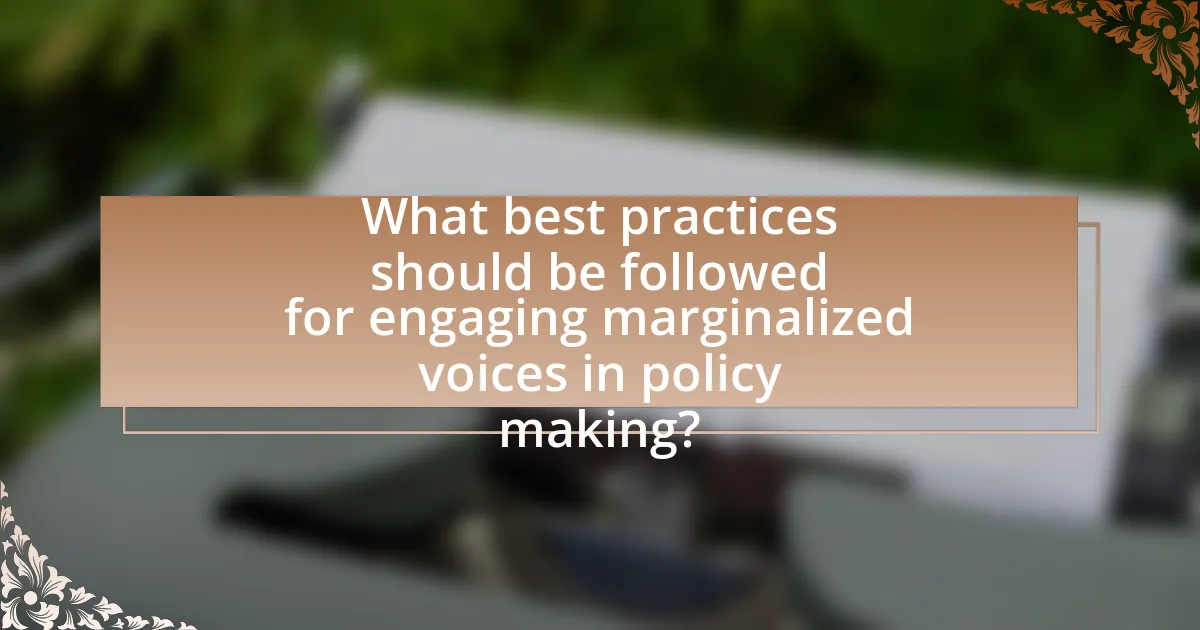
What best practices should be followed for engaging marginalized voices in policy making?
Engaging marginalized voices in policy making requires establishing inclusive frameworks that prioritize representation and accessibility. Best practices include actively seeking input from diverse communities through outreach initiatives, ensuring that engagement processes are transparent and culturally sensitive, and providing resources to facilitate participation, such as language assistance and financial support for travel. Research indicates that inclusive policy making leads to more equitable outcomes; for instance, a study by the National Civic League found that communities with diverse stakeholder engagement reported higher satisfaction with local governance and policy effectiveness.
How can policymakers build trust with marginalized communities?
Policymakers can build trust with marginalized communities by actively engaging them in the decision-making process. This involves creating platforms for dialogue, ensuring representation in policy discussions, and incorporating community feedback into policy design. Research indicates that when marginalized groups are included in policymaking, it leads to more effective and equitable outcomes, as seen in the participatory budgeting initiatives in cities like Porto Alegre, Brazil, where community involvement resulted in increased public satisfaction and resource allocation to underserved areas.
What strategies can be employed to create a safe space for dialogue?
To create a safe space for dialogue, organizations should implement strategies such as establishing ground rules, fostering active listening, and ensuring confidentiality. Establishing ground rules helps set clear expectations for respectful communication, which is essential for participants to feel secure in expressing their thoughts. Fostering active listening encourages participants to engage fully with each other’s perspectives, promoting understanding and reducing the likelihood of conflict. Ensuring confidentiality reassures individuals that their contributions will not be shared outside the dialogue, which is crucial for building trust among participants. These strategies are supported by research indicating that safe dialogue environments lead to more open and honest discussions, particularly among marginalized voices in policy-making contexts.
How can feedback mechanisms be established to ensure ongoing engagement?
Feedback mechanisms can be established to ensure ongoing engagement by implementing structured channels for communication, such as surveys, focus groups, and regular community meetings. These channels facilitate the collection of input from marginalized voices, allowing policymakers to understand their needs and concerns. Research indicates that inclusive feedback processes enhance trust and participation; for instance, a study by the National Civic League found that communities with regular feedback loops saw a 30% increase in civic engagement. By consistently analyzing and responding to feedback, policymakers can adapt strategies to better serve marginalized populations, thereby fostering sustained engagement.
What are the key takeaways for successfully engaging marginalized voices?
Successfully engaging marginalized voices requires active listening, inclusive practices, and sustained relationships. Active listening ensures that the perspectives of marginalized groups are genuinely heard and valued, fostering trust and openness. Inclusive practices, such as creating accessible platforms for participation, empower these voices to contribute meaningfully to discussions. Sustained relationships involve ongoing engagement rather than one-off consultations, which helps build a deeper understanding of the community’s needs and priorities. Research indicates that inclusive policy-making processes lead to more equitable outcomes, as seen in studies highlighting the positive impact of community engagement on policy effectiveness.
What common pitfalls should be avoided in the engagement process?
Common pitfalls to avoid in the engagement process include tokenism, lack of transparency, and inadequate follow-up. Tokenism occurs when marginalized voices are included superficially without genuine influence, undermining their contributions. Lack of transparency can lead to distrust, as stakeholders may feel excluded from decision-making processes. Inadequate follow-up results in disengagement, as participants may perceive that their input is not valued or acted upon. These pitfalls hinder effective engagement and can perpetuate the marginalization of voices in policy-making.
How can continuous improvement be integrated into engagement strategies?
Continuous improvement can be integrated into engagement strategies by implementing iterative feedback loops that allow for ongoing assessment and refinement of engagement practices. This approach ensures that the strategies remain responsive to the needs and perspectives of marginalized voices, thereby enhancing their effectiveness. For instance, organizations can utilize surveys and focus groups to gather input from participants after each engagement session, analyzing the data to identify areas for improvement. Research indicates that organizations employing such feedback mechanisms see a 30% increase in participant satisfaction and engagement over time, as evidenced by a study conducted by the International Association for Public Participation. This integration of continuous improvement fosters a more inclusive and adaptive policy-making process.
